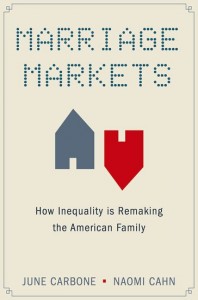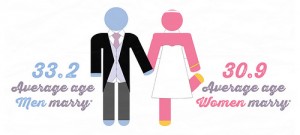This paper is part of the Council on Contemporary Families’ Online Symposium “New Inequalities.”.
Contrary to popular opinion, growing instability in American families, reflected not just in divorce rates but falling rates of marriage and high rates of unwed motherhood, is not caused by people abandoning traditional concerns for children’s well-being. It is a class issue caused by the growing gap between the job options, resources, economic stability, and personal safety nets available to college-educated Americans and less-educated workers. The authors explain.
–Stephanie Coontz
For the past two decades, countless media reports have claimed that we face a crisis in Americans’ commitment to their children, as falling rates of marriage, high divorce rates, and soaring numbers of non-marital births have affected millions of children. Contrary to popular opinion, this crisis is not caused by people abandoning traditional concerns for children’s well-being. It is a class crisis caused by the growing gap between the job options, resources, economic stability, and personal safety nets available to college-educated Americans and less-educated workers.

In youth achievement, the still-persistent race gap declined as the social class gap increased
In 1950, the biggest gaps in children’s well-being and achievement were those of race. On standardized reading scores, for example, whites did one-and-a-half times better than African- Americans. While high income conferred many advantages in life, being white outweighed being wealthy in children’s test scores: The difference in reading scores between the ninetieth and tenth percentiles of the population (measured by income) was less than half as large as the difference by race.
Over the last half century, racial disparities have shrunk significantly. By contrast, income-based differences within racial groups have increased substantially. Today, the
achievement gap tied to income is 30 to 40 percent higher than it was twenty-five years ago. It is now nearly twice as large as the black-white achievement gap. In all racial groups, children whose parents’ incomes are in the ninetieth percentile of the income ladder dramatically outperform not only the bottom group, but also the middle of the income distribution. Our children experience a far more unequal world than we did, and our grandchildren will have even more of their futures determined by the circumstances of their birth.
Even more significantly, divorce rates for college graduates in their prime child-rearing years have fallen back to the level of the sixties – before no fault divorce. For everyone else, divorce rates, after a brief hiatus, resumed their upward climb. The net result: for college graduates – but only for college graduates – the likelihood that a fourteen-year-old daughter would be living with both parents increased between the seventies and the first decade of the twenty-first century. This was true for both white and African-American college graduates. For everyone else, the combination of rising divorce and non-marital birth rates produced much less stable families.
Why are the children of college-educated parents now more likely to grow up in stable, married families? At a time of increased competition for the remaining good jobs in the
American economy, college graduates have been able to adopt a new family strategy. In the ’70s, as premarital sex increased, shotgun marriages plummeted, and divorce became easier to get, both college-educated and working-class Americans experienced more sex, higher divorce rates, and increasing numbers of intimate partners. College-educated individuals rejected traditional marital norms especially quickly, embracing the sexual revolution, adopting new gender roles and values, expressing skepticism about the sanctity of marriage, and rejecting the 1950s blanket condemnation of cohabitation and divorce.
By the middle of the ’90s, however, college-educated couples were rediscovering the benefits of marriage, now that it had been stripped of at least some of its 1950s rigidity. With the official end of “head and master” laws, the increased protections against domestic violence and sexual coercion within marriage, and new professional opportunities, accompanied by dramatic gains in real wages, educated women began to find marriage a better deal. And men began to appreciate the advantage of having a wife who could pull her own weight economically and intellectually.

Today, college-educated women postpone marriage and childbearing until their education and training are complete, both by using contraception more consistently and by resorting to abortion more often when contraception fails. Those who wait until their late twenties and early thirties to begin family life find that they have a clearer read on prospective partners. College-educated men and women have also become more likely than in the 1950s and 1960s to marry a similarly educated mate, and college-educated workers have experienced dramatic wage gains in relation to less-educated workers.
Marriage and education trends help explain the gaps
In direct contradiction to periodic media scare stories about how educated and high-earning women face a shortage of men, female college graduates have access to a much larger pool of men who are “good catches” than other women. College-educated woman have made dramatic absolute wage gains, increasing their own attractiveness as partners. At the same time, the wage gap between men and women’s incomes, which has shrunk for the country as a whole, has grown at the top. More men than women have benefitted from the bonuses on Wall Street and in the executive ranks. And elite competition, with winner-take-all rewards, takes the form of longer hours, which often disadvantages women compared to males in similar jobs. In this college-educated and elite “marriage market,” high-earning men outnumber high-earning women. The best educated and highest earning women used to be just enough to reinforce women’s incentives to marry.
Once married, college-educated couples have the income and savings necessary to invest ever more time and attention in their children. Some researchers find that the happiest couples are those where neither spouse does the housework: While time spent on childcare has increased, time spent on cooking, cleaning and laundry has ironing has declined, and those who can hire someone else to do the remaining chores experience much less stress. Graduates have also been spared many of the destabilizing effects associated with the declining real wages and job security experienced by less-educated workers over the past 30 years.
The real wages and job prospects of female high school graduates have increased over the past 40 years, but those of male high school graduates have fallen sharply. The result is that the wage gap between men and women has shrunk. Yet the working class holds more traditional attitudes about the importance of male breadwinning than do college graduates. Male high school graduates used to be able to support a family on their wages. Today, their inability to do so is a major factor in family instability.Women who do not go on to college live in neighborhoods and work in sectors of the economy where they meet a much less attractive group of potential marriage partners that their college-educated counterparts. Many of the men in these communities cycle in and out of dead end jobs. They face long periods of unemployment or underemployment. They have become more likely than a half century ago to experience brushes with the criminal justice system, and these are much more likely than in the past to result in jail time. It only takes a few bad experiences for women to decide to invest in themselves.
Whatever their marriage prospects, most women still want children. If they become jaded about the men in their communities, they see little reason to wait for marriage to have a child because they do not expect that delaying pregnancy will increase the likelihood of finding a man who can or will pull his own weight in a relationship.
In spite of stagnant wages, unstable families, and greater parental stress, those on the losing end of societal changes do not invest less in their children than they have done in the past. But they have been unable to increase their investment of time and resources as quickly as their more educated counterparts. In the mid-’70s, high school graduate mothers spent four minutes more each day with their children than mothers who were college graduates. By the second half of the 2000s, they had doubled their time with children. But college graduate mothers had increased their time with children even more substantially – by a factor of four to five. The net result: college graduate mothers now spend 50 minutes a day more with their children than mothers who only graduated from high school. Taking fathers into account further increases the time gap to almost an hour a day.
As the top invest even more in their children, the payoffs are not only in terms of test scores or college completion rates but also athletic participation, participation in religious and/or civic organizations, community involvement – and marriage rates. In the meantime, families who enjoy neither stability nor community and workplace support struggle to stay even or make modest progress. Even when they succeed in achieving stable families, they fall further behind in our winner-take-all economy.

Comments 4
Robert B. Pettit — October 8, 2014
"The net result: for college graduates – but only for college graduates – the likelihood that a fourteen-year-old daughter would be living with both parents increased between the seventies and the first decade of the twentieth century." Don't you mean "twenty-first century"?